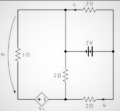I tried to solve the equations I got but when I make substitutions I get to a deadlock where I can't substitute anything anymore.
The equations I obtained are:
i2=i1+i2
i3=i4+i5
i5=i7-i6
i2=i4+i6
3i2-i1R1-i5R2=0
2v-i2R3=0
-i6R4+2v-i5R2=0
Could someone help me understand step by step what procedures to perform to get to the solution.
I thank you all anyway and have a good evening, see you soon!

The equations I obtained are:
i2=i1+i2
i3=i4+i5
i5=i7-i6
i2=i4+i6
3i2-i1R1-i5R2=0
2v-i2R3=0
-i6R4+2v-i5R2=0
Could someone help me understand step by step what procedures to perform to get to the solution.
I thank you all anyway and have a good evening, see you soon!











